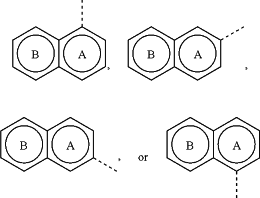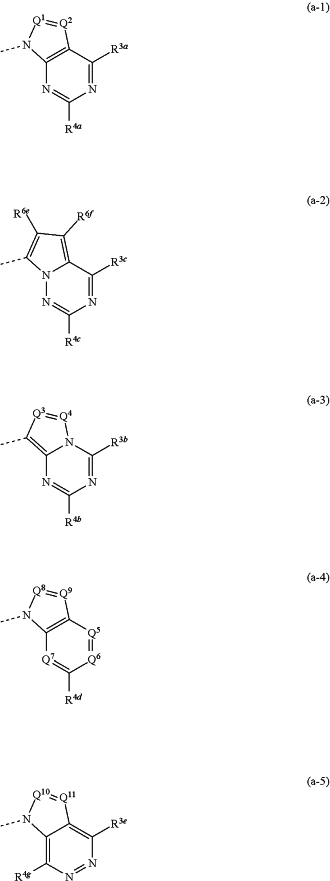| CPC A61K 31/7076 (2013.01) [A61K 31/5025 (2013.01); A61K 31/519 (2013.01); A61K 31/53 (2013.01); A61P 35/00 (2018.01); C07D 471/04 (2013.01)] | 19 Claims |
|
1. A compound of Formula (I)
 wherein
R1 represents hydrogen or —C(═O)—C1-4alkyl;
R2 represents hydrogen or —C(═O)—C1-4alkyl;
Y represents —O—, —CH2— or —CF2—;
Z represents —CH2—, —X—CR5aR5b—, —CR5c═CR5d—, —CR5eR5g—CR5fR5h—, or —C≡C—;
and when Y represents —CH2— or —CF2—, then Z can also represent —O— or —CR5aR5b—X;
R5aR5b, R5c, R5d, R5e, R5f, R5g, and R5h each independently represent hydrogen or C1-4alkyl;
X represents —O—, —S—, or —NR11—;
R11 represents hydrogen, C1-4alkyl, or C1-4alkyl substituted with one substituent selected from the group consisting of —OH, —O—C1-4alkyl, R12, —NH2, —NH—C1-4alkyl, and —N(C1-4alkyl)2;
R12 represents a 4-, 5-, 6- or 7-membered heterocyclic ring containing one nitrogen atom and optionally one oxygen atom; said 4-, 5-, 6- or 7-membered heterocyclic ring being attached to the remainder of the molecule via a ring nitrogen atom;
Ar represents a 10-membered bicyclic aromatic ring system consisting of two fused 6-membered rings,
 wherein at least 1 ring carbon atom of ring B is replaced by a nitrogen atom;
wherein optionally 1 additional ring carbon atom of ring A or ring B is replaced by a nitrogen atom; provided that when a nitrogen atom replaces one of the two fused carbon atoms, a carbonyl group is present in said bicyclic aromatic ring system;
Ar is optionally substituted with one, two, three or four substituents each independently selected from the group consisting of halo, —OH, —NH2, —NH—C1-4alkyl, —N(C1-4alkyl)2, —NHR10d, —NR10cR10d, cyano, —CF3, —C(═O)—NH2, —C(═O)—NH—C1-4alkyl, —C(═O)—C1-4alkyl, C1-4alkyloxy, —C(═O)—O—C1-4alkyl, C3-6cycloalkyl, —O—C3-6cycloalkyl, —NH—C3-6cycloalkyl, —N(C3-6cycloalkyl)2, C2-6alkenyl, C1-4alkyl substituted with one C1-4alkyloxy, and C1-4alkyl optionally substituted with one —NR10aR10b;
R10a and R10b each independently represent hydrogen or C1-4alkyl;
R10c and R10d each independently represent C3-6cycloalkyl; R13; R14; C3-6cycloalkyl substituted with one, two or three substituents each independently selected from the group consisting of halo, —OH and —O—C1-4alkyl; C1-4alkyl substituted with one, two or three substituents each independently selected from the group consisting of halo, —OH and —O—C1-4alkyl; or C1-4alkyl substituted with one substituent selected from the group consisting of C3-6cycloalkyl, R13 and R14;
R13 represents a 4- to 7-membered monocyclic aromatic ring containing one, two or three heteroatoms each independently selected from O, S, S(═O)p and N; or a 6- to 11-membered bicyclic fused aromatic ring containing one, two or three heteroatoms each independently selected from O, S, S(═O)p and N;
said 4- to 7-membered monocyclic aromatic ring or 6- to 11-membered bicyclic fused aromatic ring is optionally substituted with one or two substituents selected from the group consisting of C1-4alkyl;
p represents 1 or 2;
R14 represents phenyl optionally substituted with one, two or three substituents each independently selected from the group consisting of halo;
Het represents a bicyclic aromatic heterocyclic ring system selected from the group consisting of (a-1), (a-2), (a-3), (a-4) and (a-5):
 R3a, R3b, R3c, R3d and R3e each independently represent hydrogen, halo, —NR7aR7b, C1-4alkyl, C2-4alkenyl, C3-6cycloalkyl, —OH, or —O—C1-4alkyl;
R7a represents hydrogen;
R7b represents hydrogen, C3-6Cycloalkyl, or C1-4alkyl;
R4a, R4b, R4c, R4d, R4e, R4f and R4g each independently represent hydrogen, halo, —NR8aR8b, or C1-4alkyl;
R8a and R8b each independently represent hydrogen or C1-4alkyl;
Q1 represents N or CR6a;
Q2 represents N or CR6b;
Q3 represents N or CR6c;
Q4 represents N or CR6d;
provided that maximum one of Q3 and Q4 represents N;
Q8 represents N or CR6g;
Q9 represents N or CR6h;
Q10 represents N or CR6i;
Q11 represents N or CR6j;
Q5 represents CR3d; Q6 represents N; and Q7 represents CR4f; or
Q5 represents CR3d; Q6 represents CR4e; and Q7 represents N; or
Q5 represents N; Q6 represents CR4e; and Q7 represents CR4f; or
Q5 represents N; Q6 represents CR4e; and Q7 represents N; or
Q5 represents N; Q6 represents N; and Q7 represents CR4f; or
Q5 represents N; Q6 represents N; and Q7 represents N;
R6a, R6b, R6c, R6d, R6e, R6f, R6g, R6h, R6i and R6j each independently represent hydrogen, halogen, C1-4alkyl, —NR9aR9b, or C1-4alkyl substituted with one, two or three halo atoms;
R9a and R9b each independently represent hydrogen or C1s-4alkyl;
or a pharmaceutically acceptable addition salt or a solvate thereof.
|